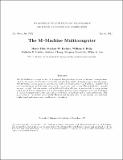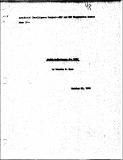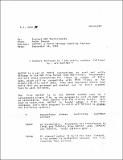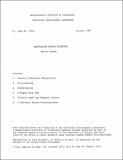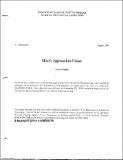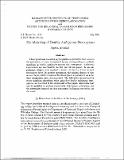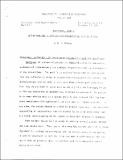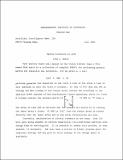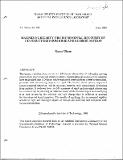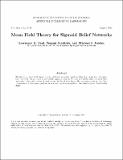Browsing AI Memos (1959 - 2004) by Title
Now showing items 593-612 of 1217
-
The M-Machine Multicomputer
(1995-03-01)The M-Machine is an experimental multicomputer being developed to test architectural concepts motivated by the constraints of modern semiconductor technology and the demands of programming systems. The M- Machine computing ... -
MAC PDP-6 DECtape File Structure
(1965-07-01)The MAC system programs, MACDMP, TECO, and MIDAS, assume a certain data structure on DECtapes which they handle. Each DECtape has 1100 blocks of 200 words, numbered 0 through 1077. Block 0 and blocks 1070 through 1077 are ... -
Machine Recognition as Representation and Search
(1989-12-01)Generality, representation, and control have been the central issues in machine recognition. Model-based recognition is the search for consistent matches of the model and image features. We present a comparative ... -
MACRO Definitions for LISP
(1963-10-01)In LISP 1.5 special forms are used for three logically separate purposes: a) to reach the alist, b) to allow functions to have an indefinite number of arguments, and c) to keep arguments from being evaluated. New LISP ... -
MACTAP: A PDP-6 DECtape Handling Package
(1965-09-01)MACTAP is a set of PDP-6 subroutines to read and write DECtape in the MAC file format (see MAC-M-249). Programmers can call these subroutines for input or output of ASCII data, which will be compatible with TECO files; or ... -
Making Aesthetic Choices
(1979-03-01)A framework is presented for making choices that are primarily constrained by aesthetic, as opposed to, pragmatic considerations. An example of the application of this framework is a computer system called "Ani", capable ... -
The Making of the Film, SOLAR CORONA
(1973-02-01)The film SOLAR CORONA was made from data taken from August 14, 1969 through May 7, 1970, by OSO-VI, one of the Orbiting Satellite Observatories. One of the experiments on board scanned across and up and down the image of ... -
Manipulator Design Vignettes
(1981-10-01)This memo is about mechanical arms. The literature on robotics seems to be deficient in such discussions, perhaps because not enough sharp theoretical problems have been formulated to attract interest. I"m sure many of ... -
Manipulator Design Vignettes
(1972-10-01)This memo is about mechanical arms. The literature on robotics seems to be deficient in such discussions, perhaps because not enough sharp theoretical problems have been formulated to attract interest. I'm sure many ... -
Marr's Approach to Vision
(1981-08-01)In the last seven years a new computational approach has led to promising advances in the understanding of biological visual perception. The foundations of the approach are largely due to the work of a single man, ... -
Massively Parallel Implementations of Theories for Apparent Motion
(1987-06-01)We investigate two ways of solving the correspondence problem for motion using the assumptions of minimal mapping and rigidity. Massively parallel analog networks are designed to implement these theories. Their ... -
The Matching of Doubly Ambiguous Stereograms
(1991-07-01)I have previously described psychophysical experiments that involved the perception of many transparent layers, corresponding to multiple matching, in doubly ambiguous random dot stereograms. Additional experiments ... -
MATHSCOPE Part I: A Proposal for a Mathematical Manipulation-Display System
(1963-11-01)Mathscope: A compiler for two-dimensional mathematical picture syntax. Mathscope is a proposed program for displaying publication-quality mathematical expressions given symbolic (list-structure) representations of the ... -
Matrix Inversion in LISP
(1967-07-01)Very shortly there will appear on the vision library tape a field named @IAS which is a collection of compiled SUBR"s for performing general matrix row reduction and inversions. For an array A a call (IAS A NEW N M) performs ... -
Matter, Mind and Models
(1965-03-01)This paper attempts to explain why people become confused by questions about the relation between menal and physical events. When a question leads to confused, inconsistent answers, this may be (1) because the question is ... -
Maximizing Rigidity: The Incremental Recovery of 3-D Structure from Rigid and Rubbery Motion
(1983-06-01)The human visual system can extract 3-D shape information of unfamiliar moving objects from their projected transformations. Computational studies of this capacity have established that 3-D shape, can be extracted ... -
Maxwell's Demon, Rectifiers, and the Second Law: Computer Simulation of Smoluchowski's Trapdoor
(1991-09-01)We have simulated numerically an automated Maxwell's demon inspired by Smoluchowski's ideas of 1912. Two gas chambers of equal area are connected via an opening that is covered by a trapdoor. The trapdoor can open to ... -
Mean Field Theory for Sigmoid Belief Networks
(1996-08-01)We develop a mean field theory for sigmoid belief networks based on ideas from statistical mechanics. Our mean field theory provides a tractable approximation to the true probability distribution in these networks; it ... -
Measure Fields for Function Approximation
(1993-06-01)The computation of a piecewise smooth function that approximates a finite set of data points may be decomposed into two decoupled tasks: first, the computation of the locally smooth models, and hence, the segmentation ... -
The Measurement of Visual Motion
(1982-12-01)The analysis of visual motion divides naturally into two stages: the first is the measurement of motion, for example, the assignment of direction and magnitude of velocity to elements in the image, on the basis of the ...
